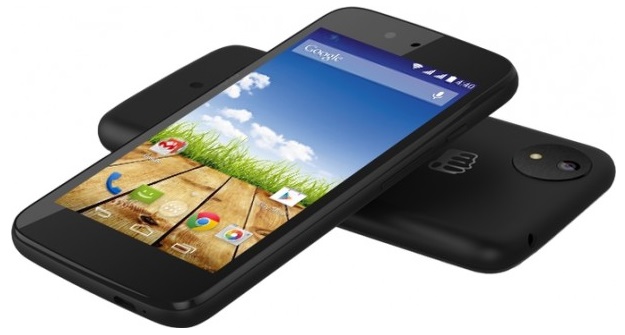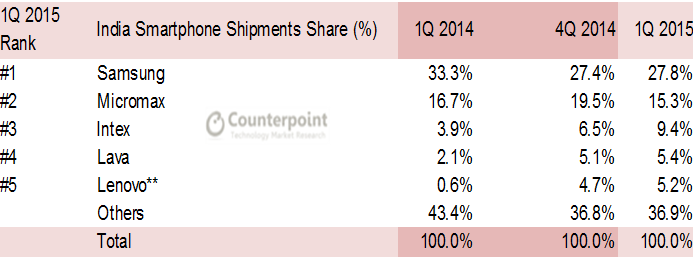Android One is not doing well. Last week, the second-generation of Android One devices launched in India spearheaded by the Lava Pixel V1, featuring an outdated 2013 MediaTek SoC, lackluster performance, no 4G support and outright duplicitous marketing with the 8MP/5MP camera combination “software enhanced” to 13MP/8MP and the press-renders which show an almost bezel-less display.
![]()
Some Background
Going by the numbers, from September 2014 launch till May 31st 2015, about 800,000 Android One smartphones were shipped. This is about a third of the total sub-$100 smartphones sent to India during Jan-Mar 2015. But these are just shipments, not actual sales. At present Android One smartphones are selling for as low as Rs. 4000 on several retailers down from the initial launch price of about Rs. 6300, which goes to show the lack of consumer interest.

The major roadblock with the previous-gen Android One smartphones was availability across all retail channels. According to industry estimates, around 80% smartphone sales still come through offline channels and this is where Google and its partners faltered. They learned later and after a short while all Android One smartphones were available through offline channels as well, with Spice Mobility saying that almost 80% sales of its initial stock of 1,00,000 units in November 2014 came from offline channels.
So this time around, Lava and Google decided that they would make the Pixel V1 available through both offline and online channels. Flipkart was chosen as the exclusive online partner while it will be available through 2000 retail stores and over 65000 multi-brand outlets as well. Lesson learnt.
Lava Pixel V1 and the Deceitful Marketing Strategies
![]()
I understand specs don’t matter much when it comes to user experience. It’s a culmination of hardware, software, design (UI, Build, Ergonomics) which make usability better. With rapidly evolving technology, hardware is progressing at a much faster rate than software can ever match. Therefore even older hardware can run current-gen software with optimizations.
![]()
That’s not the case with the Lava Pixel V1. It runs on an outdated 2013 MediaTek MT6582 SoC which in-fact was the same SoC found on the previous-gen Android One smartphones. Even when Android One smartphones were launched in September last year, it was an outdated SoC, but for the price it seemed a good bet. This time around the Lava Pixel V1 costs twice as much with a 2 year old chipset at Rs. 11,349.
The build and design are far better than the previous-gen Android One devices which shared a common mould. But for the price, Lava Pixel V1 doesn’t offer much. Google should’ve tapped Motorola for the second-gen Android One launch with the 3rd-gen Moto G which offers a far better experience both in terms of usability and features.
Lava Pixel V1 vs Motorola Moto G 3rd-Gen Specs Comparison
![]()
Coming back to the Pixel V1, some specs have been bumped from the previous-gen Android One devices. You now get a 5.5-inch 720p HD IPS display - which looks washed out, 2GB RAM – a welcome addition and 32 GB onboard storage – a real surprise but running on Android 5.1 Lollipop which is still a version behind (The new Moto G 3rd-gen, Samsung Galaxy J5 all run Android 5.1.1 Lollipop out of the box).
![]()
Then there’s no 4G LTE support, performance is lackluster with lag in various UI elements, sluggish web-browsing, and huge camera shutter lag, probably due to the “software enhancement.” Which brings me to the point about deceitful marketing strategies.
You wouldn’t see the mention of “software enhanced” cameras anywhere with the online store listing of the Lava Pixel V1 and the press renders all show an edge-to-edge display, while in reality there is a huge black-border surrounding it.
![]()
The images on the box pack show the same press-render, and imagine your surprise when you boot up the phone. On the box however its mentioned that the cameras are “software enhanced.”
Essentially, the Lava Pixel V1 has a 8MP rear camera which stitches together images to interpolate to 13MP, and a 5MP front camera does the same to 8MP. There is a huge delay in capturing the image, and the time it is saved resulting in shutter lag and blurry results.

Lava at present holds about 5.4% market-share in terms of smartphones sales in the country as per last quarter with Lenovo/Motorola clawing their way with a 5.2% market-share and the likes of Xiaomi (leading 4G smartphone brand) making strong inroads.
These false marketing stunts aren’t going to win Lava any loyal customers and its surprising to see Google signing-off on this. It seems that Google has given-up on Android One, even if they are denying it.
“We're not backing away from the programme," Caesar Sengupta, vice president of product management at Google said in an interview to ET. "We've learnt a lot from the initial round with our partners and they have learnt in terms of device availability, in channel and others. Over time, as we work with our partners, we will keep working on making sure that we do things much better."
The Great Divide
It seems there is a huge disconnect between Android One partners and Google’s core Android One team. This clearly shows with the Lava Pixel V1 launch. From a company that is completely lost on what consumers want and what the future holds, to the deceitful and gimmicky marketing tactics which are being employed here.
Its actually sad to see the demise of a promising project to make smartphones affordable, the first internet enabled device for many. The Lava Pixel V1 is neither affordable nor worth investing in. It is an utter failure at everything Android One was supposed to be.
![]()
Google’s “Android One” name is stamped at the back of each one of these phones and the horrid performance, false marketing that we see here will bury this project for good.



























